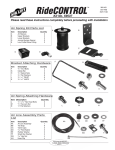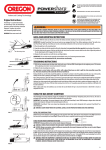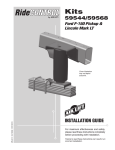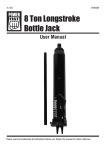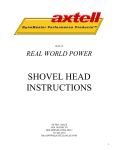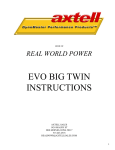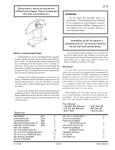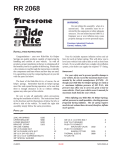Download Network Computing Devices 2190 User's Manual
Transcript
2190 WARNING! Do not inflate this assembly when it is unrestricted. The assembly must be restricted by the suspension or other adequate structure. Do not inflate beyond 100 P.S.I. Improper use or over inflation may cause property damage or severe personal injury. INSTALLATION INSTRUCTIONS Congratulations - your new Air Helper Springs are quality products capable of improving the handling and comfort of your vehicle. As with all products, proper installation is the key to obtaining all of the benefits your kit is capable of delivering. Please take a few minutes to read through the instructions to identify the components and learn where and how they are used. It is a good idea to start by comparing the parts in your kit with the parts list below. The heart of the Air Helper Spring kit is, of course, the air helper springs. Remember that the air helper springs must flex and expand during operation, so be sure that there is enough clearance to do so without rubbing against any other part of the vehicle. Be sure to take all applicable safety precautions during the installation of the kit. The instructions listed in this brochure and the illustrations all show the left, or driver’s side of the vehicle. To install the right side assembly simply follow the same procedures. PARTS LIST AIR SPRING 6781 UPPER BRACKET 5178 LOWER BRACKET 5250 FRAME BRACE (LEFT) 5249 FRAME BRACE (RIGHT) 5248 18 ft. TUBING 0938 3/8"-16 X 4" HEX BOLT 3/8"-16 FLANGED LOCK NUT 3/8"-16 X 3/4" FLANGED HEX BOLT 21-8178 2 2 2 1 1 1 4 8 2 Your kit includes separate inflation valves and air lines for each air helper spring. This will allow you to level your vehicle from side to side as well as from front to back. If you would rather have a single valve inflation system, your dealer can supply the required "T" fitting. IMPORTANT! For your safety and to prevent possible damage to your vehicle, do not exceed the maximum load recommended by the vehicle manufacturer (GVWR). Although your Air Helper Springs are rated at a maximum inflation pressure of 100 psi, this pressure may allow you to carry too great a load on some vehicles. It is best to have your vehicle weighed once it is completely loaded and compare that weight to the maximum allowed. Check your vehicle owner’s manual or data plate on driver side door for maximum loads listed for your vehicle. When inflating your Air Helper Springs, add air pressure in small quantities, checking pressure frequently during inflation. The air spring requires much less air volume than a tire and, therefore, inflates much quicker. 5/16" FLAT WASHER J-BOLT 5/16" -18 FLANGED LOCK NUT HEAT SHIELD PUSH-TO-CONNECT INFLATION VALVE PUSH-TO-CONNECT ELBOW THERMALSLEEVE NYLON TIES 12-03 1004 3101 3098 0899 4 8 8 1 2 2 2 7 NCD-6037-2 2190 / 6011 KIT TO FRAME ASSEMBLY NOTE: Both illustrations are of the left, or drivers side, of the truck. Refer to step 3 for the proper lower bracket alignment. BRAKE-LINE BRACKET BRAKE-LINE / AXLE VENT TUBE CLIP FRAME BRACE F R A M E 3/8” -16 x 4” HEX BOLTS KIT ASSEMBLY DRILL TWO 7/16” HOLES 3/8” -16 FLANGED LOCK NUT UPPER BRACKET JOUNCE BUMPER BRACE 3/8” -16 FLANGED HEX NUT AIR FITTING AIR LINE 5/16” -18 FLANGED HEX NUT LEAF STACK J-BOLT INSTALLATION LOCATION 5/16” -18 FLANGED HEX NUT AIR SPRING JOUNCE PAD J-BOLT 3/8” -16 x 3/4” FLANGED HEX BOLT L E E H W F R O N T LOWER BRACKET FIGURE "A" AXLE FRAME RAIL FRAME BRACE AIR SPRING UPPER BRACKET LOWER BRACKET J-BOLT DRIVER'S SIDE BRAKE LINE FRONT SHOCK BRACKET JOUNCE PAD FIGURE "B" STEP 1 - PREPARE THE VEHICLE Remove the positive battery cable. With the vehicle on a solid, level surface chock the front wheels. Raise the vehicle by the axle and remove the rear wheels. After the removal of the wheels lower the vehicle so the axle rests on jack stands rated to support your vehicles weight. This installation assumes that there is no load in the bed of the truck. Your vehicle is equipped with rubber jounce bumpers. The bumpers are attached to the frame directly above the axle. Remove these bumpers by unbolting from the inside of the frame flange see Figure "C". This bumper will not be reused with this kit. The brake line bracket and brake-line/axle vent tube clip will need to be loosened and removed to allow installation of the frame brace. The brake-line bracket is attached to the top flange of the frame with two hex bolts. Remove the hex bolts to allow the brake-line bracket to be moved far enough to facilitate installation of the frame brace. The brake-line/axle vent tube clip is attached to the top of the upper frame flange with a plastic pin. Remove the pin with a panel tool or screw driver see Figure "C". Pull the clip out of the way of the frame brace. PLASTIC PIN BRAKE-LINE/ AXLE VENT TUBE CLIP FACTORY BOLTS F R A M E PIN BRAKE-LINE BRACKET JOUNCE BUMPER FIGURE "C" STEP 2 - PRE-ASSEMBLE THE KIT Pre-assembly will begin with the left (driver's) side of the vehicle. All pictures depict the installation on the left side of the vehicle unless noted otherwise. Select one of the air springs and install the push-to-connect air fitting in the top threaded hole and tighten securely. Tighten the air fitting so as to make contact with the nylon ring and then tighten 1/4 turn to snug fitting. No thread sealant is needed. Secure the upper bracket to the air spring using 3/8" -16 flanged lock nuts. Next, select a lower bracket and secure to the air spring using a 3/8" -16 x 3/4" flanged hex bolt see Figure "A". Be sure that the lower bracket is attached to the air spring so that the bracket orientation is perpendicular to the upper bracket. When the upper bracket of the air spring assembly is attached to the frame rail, the lower bracket should rest in-line on top of the axle without twisting the air spring see Figures "A" & "B". STEP 3 - INSTALL THE ASSEMBLY TO THE VEHICLE TIE RIGHT PARKING BRAKE-LINE TO BRAKE-LINE BRACKET ON AXLE FIGURE "D" HEAT SHIELD FIGURE "E" Insert the left-side frame brace into the frame rail so that it straddles the jounce bumper brace see Figure "A". Ensure that the frame brace does not pinch any existing brake, electrical, or fuel lines that may be inside the frame rail. The brakeline bracket and brake-line/axle vent tube clip will have to be held clear to allow installation of the frame brace. Place the air spring assembly on top of the jounce bumper pad on top of the axle housing. Align the air spring over the axle. Slide the upper bracket onto the frame rail and frame brace. Visually align the holes in the upper bracket with the slots in the frame brace. It may be necessary to use a rubber mallet to force the upper bracket onto the frame. Mark the frame with a center punch in the center of the holes on the upper bracket. Use the upper bracket as a template to drill two 7/16" mounting holes in the frame rail see Figure "A". Before drilling the holes make sure all electrical, brake, and fuel lines are cleared from the path of the drill. In order to prevent any damage to these lines it is recommended that a thin piece of wood be placed between the frame rail and the existing lines. Attach the upper bracket with the 3/8"-16 x 4" hex bolts and 3/8" -16 flanged hex nuts see Figures "A" & "B". With the assembly attached to the frame rail, the next step is to attach the lower bracket to the jounce pad on the axle housing. Center the lower bracket on the jounce pad. Use the J-bolts and 5/16" -18 flanged lock nuts to secure the lower bracket to the jounce pad see Figures "A" & "B". Spin the nuts on as far as possible by hand. While making sure that the lower bracket stays centered on the jounce pad, tighten each nut two turns at a time with a wrench, switching to opposite nuts to ensure that the bracket is mounted evenly on the jounce pad. After the installation of the left-side assembly is complete, re-attach the brake-line bracket and brake-line/axle vent tube clip to the frame. Important: In order for the air spring to function properly, there must be a minimum of 1/2" of clearance around the air spring. The right-side parking brake-line must be tied to the brake-line bracket on the axle housing to prevent it from interfering with the normal operation of the left-side air spring see Figure "D". AIR SPRINGS AIR HOSE STEP 4 - INSTALL THE PASSENGER'S SIDE ASSEMBLY Follow steps 2 - 5 for assembly and installation of the passenger's side assembly. Note: The use of a heat shield is required on the passenger's side of the vehicle. The heat shield will mount between the upper bracket and the air helper spring see Figure "E". Position the shield halfway between the nearest point of the exhaust pipe to the rubber air spring. Ensure that the heat shield will not interfere with the normal operation of the air spring or the vehicle's suspension. Do not position the face of the shield directly over the axle, as it may contact the axle on full suspension compression. INFLATION VALVES BUMPER FIGURE "F" AIR LINE FLAT WASHER STEP 5 - INSTALL THE AIR LINE AND INFLATION VALVE Uncoil the air tubing and cut it in two equal lengths. DO NOT FOLD OR KINK PUSH-TO-CONNECT INFLATION VALVE THE TUBING. Make the cut as square as possible. Insert one end of the tubing BODY OF into the push-to-connect elbow fitting installed in the top of the air helper spring VEHICLE as far as possible. Select a location on the vehicle for the air inflation valves. The location can be HEX NUT VALVE CAP on the bumper or the body of the vehicle, as long as it is in a protected location so the valve will not be damaged, but still maintain accessibility for the air chuck see FIGURE "G" Figure "F". Drill a 5/16" hole and install the air inflation valve using two 5/16" flat washers per valve as supports see Figure "G". Run the tubing from the air helper spring to the valve, routing it to avoid direct heat from the engine, exhaust pipe, and away from sharp edges. Thermal sleeves have been provided for these conditions. The air line tubing should not be bent or curved sharply as it may buckle. Secure the tubing in place with the nylon ties provided. Push the end of the air line tubing into the inflation valve see Figure "G". STEP 6 - CHECK THE AIR SYSTEM Once the inflation valves are installed, inflate the air helper springs to 70 psi and check the fittings for air leaks. Using a spray bottle, apply a solution of soap and water to the fittings. If a leak is detected at a airline tubing connection then check to make sure that the airline tube is cut as square as possible and that it is pushed completely into the fitting. The airline tubing can easily be removed from the fittings by exhausting all the pressure in the air springs and then pushing the collar towards the body of the fitting and then, with a pull, remove the airline tubing. Reinstall the tubing and reinflate the air springs and check for leaks as noted above. If a leak is detected where the air fitting screws into the spring, just screw the air fitting into the air spring until the leak stops. This now completes the installation. Install the wheels and torque the lug nuts to the manufacturer's specification. Raise the vehicle by the axle and remove the jack stands. Lower the vehicle to the ground. Reattach the negative battery cable and remove the wheel chocks from the front wheels. Before proceeding, check once again to be sure you have proper clearance around the air springs. With a load on your vehicle and the air helper springs inflated, you must have at least 1/2" clearance around the air springs. As a general rule, the air helper springs will support approximately 50 lbs. of load for each psi of inflation pressure (per pair). For example, 50 psi of inflation pressure will support a load of 2500 lbs. per pair of air helper springs. FOR BEST RIDE use only enough air pressure in the air helper springs to level the vehicle when viewed from the side (front to rear). This amount will vary depending on the load, location of load, condition of existing suspension and personal preference. NOTE: Too much air pressure in the air helper springs will result in a firmer ride, while too little air pressure will allow the air helper spring to bottom out over rough conditions. Too little air pressure will also not provide the possible improvement in handling. TO PREVENT POSSIBLE DAMAGE, MAINTAIN A MINIMUM OF 5 P.S.I. IN THE AIR HELPER SPRINGS AT ALL TIMES. NOTE: Once the air helper springs are installed, it is recommended that the vehicle not be lifted by the frame, as overextension may occur, resulting in damage to the air helper springs. However, should it become necessary to raise the vehicle by the frame, deflate both air helper springs completely.





